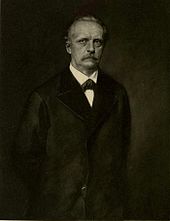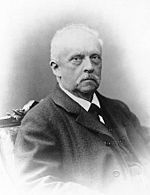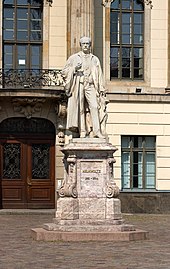Herman von Helmholtz
Hermann Ludwig Ferdinand von Helmholtz (August 31, 1821 – September 8, 1894) was a German physician and physicist, who made significant contributions to many areas of modern science. In physiology and psychology, he is known for his work on the functioning and perceptual processes of the human eye and ear. In physics, he is known for his theories on the conservation of energy, his works on electrodynamics, chemical thermodynamics, and for the mechanical foundation of thermodynamics. As a philosopher, he is known for his philosophy of science, ideas about the relationship between the laws of perception and the laws of nature, as well as his ideas about the science of aesthetics and about the civilizing power of science..
He was a co-founder in 1887 of the Physikalisch-Technische Reichsanstalt, later the current Physikalisch-Technische Bundesanstalt, together with Karl-Heinrich Schellbach and Werner von Siemens in Charlottenburg.
Early Years
Helmholtz was born in Potsdam, the eldest son of Ferdinand Helmholtz, a high school principal who had studied philology and classical philosophy, and who was a close friend of Fichte. This fact explains the later influence on Helmholtz of the ideas of Fichte and Kant, whose theories he tried to transfer to empirical activities such as psychology.
In his youth he moved to Berlin to study medicine at the Federico Guillermo Medico-Surgical Institute —called the Pépinière of Berlin—, a school that trained military doctors. He chose to study there because there was no tuition, which was important since his family was not very wealthy. However, in return he agreed to serve eight years in the army.
Four years later, Helmholtz left Pépinière as a doctor of anatomy to train at the Hospital de la Charité. In 1841 he began a doctoral thesis under the supervision of Müller. He would study the structure of the nervous system in invertebrates. He thus discovered that nerve fibers arise from cells, previously identified by Christian Gottfried Ehrenberg.
In 1843 he was assigned to the Potsdam hospital, where he worked for five years. He was able to combine his work with the investigations, since he had a lot of free time. He set up a barracks to transform it into a laboratory. There he conducted research on the production of heat during muscle contraction. He demonstrated that the heat was not carried by the blood or the nerves, but was produced in the muscles themselves. He deduced a mechanical equivalent of heat, embodied in his 1847 dissertation, Über die Erhaltung der Kraft (On the Conservation of Energy). This meant that there were no "vital forces" to move a muscle. Helmholtz rejected the speculative tradition of natural philosophy, the then dominant paradigm in German physiology.
After this, he was able to leave the army and start teaching anatomy at the Prussian Academy of Arts thanks to the help of Alexander von Humboldt.
Investigations
Mechanics
His first major scientific achievement, an 1847 Treatise on the Conservation of Energy, was written in the context of his medical studies and against a philosophical background. He discovered the principle of conservation of energy while studying muscle metabolism. He tried to show that muscle movement involves a mechanical exchange of energy, and therefore no vital force was necessary to explain it. This discovery meant the rejection of the dominant philosophical paradigm until then in German physiology, the fruit of a long speculative tradition.
Based on the earlier work of Sadi Carnot, Émile Clapeyron and James Prescott Joule, he postulated a relationship between mechanics, heat, light, electricity and magnetism, treating them as distinct manifestations of a single force (energy according to modern nomenclature). He published his theories in the book titled & # 34; Über die Erhaltung der Kraft & # 34; (On the Conservation of Force ) 1847.
In the 1850s and 1860s, publications by William Thomson, Helmholtz, and William Rankine popularized the idea of the heat death of the universe.
In fluid dynamics, Helmholtz made several contributions, including Helmholtz's Theorems on vortex dynamics in inviscid liquids.
Sensory Physiology
Helmholtz's sensory physiology was the basis for the work of Wilhelm Wundt, a student of Helmholtz's who is considered one of the founders of experimental psychology. Wundt, more explicitly than Helmholtz, described his research as a form of empirical philosophy and as a study of the mind as an independent element. Helmholtz, in his early rejection of natural philosophy, had stressed the importance of materialism and focused more on the unity of the 'mind' than on the other. and of the body.
Ophthalmic Optics
In 1851, Helmholtz revolutionized the field of ophthalmology with the invention of the ophthalmoscope; an instrument used to examine the interior of the human eye. This invention made him suddenly famous. Helmholtz's interests at this time centered increasingly on the physiology of the senses. His main publication, entitled "Handbuch der Physiologischen Optik" (Handbook of Physiological Optics or Treatise on Physiological Optics"), provided the empirical theories on the perception of depth and movement, and on color vision; becoming a fundamental reference work in his field during the second half of the XIX century. In the third and last volume, published in 1867, Helmholtz describes the importance of unconscious inference in perceptual processes. His theory of reflex accommodation was undisputed until the final decade of the XX century.
Helmholtz continued for several decades to update successive editions of his manual, reflecting his dispute with Ewald Hering who held opposing views on spatial vision and color perception. This dispute divided the discipline of physiology during the second half of the 1800s.
Nerve Physiology
In 1849, while living in Königsberg, Helmholtz measured the speed of transmission of nerve impulses. At the time, it was thought that nerve signals traveled along nerves at an enormously fast speed.To do this, he used a freshly dissected sciatic nerve from a frog, and the adjacent calf muscle. He used a galvanometer as a chronographic device, adding a mirror to reflect a beam of light into the room on a scale that gave the device's needle much greater sensitivity. Transmission speeds recorded by Helmholtz were in the range of 24.6-38.4 meters per second.
Acoustics
Helmholtz built a device to analyze the combinations of tones that generate complex natural sounds: the Helmholtz resonator, a primitive electronic musical instrument (one of the precursors) that was not born as such, since its inventor was a scientist and not he had no interest in the musical applications derived from his research.
In 1863 Helmholtz published a book entitled On the sensations of pitch as a physiological basis for the theory of music, where he again demonstrated his interest in the physics of perception. This book influenced musicologists of the 20th century.
Electromagnetism
Helmholtz moved from Bonn to Berlin in 1871, working as a professor of physics. He became interested in electromagnetism. Although he himself did not achieve celebrity for these contributions to science, his disciple Heinrich Rudolf Hertz became famous for being the first to show electromagnetic radiation. Another of his students was Max Planck.
Helmholtz wrote on many different topics. Among them, topics as divergent as the age of the Earth, the origin of the planetary system and the functioning of the basilar membrane in the cochlea. (See Helmholtz Resonator)
Work
Some posts
- Über die Erhaltung der Kraft. Reimer, Berlin 1847.
- Ueber die Wechselwirkung der Naturkräfte und die darauf bezüglichen neuesten Ermittelungen der Physik: ein populär-wissenschaftlicher Vortrag, gehalten am 7. Februar 1854. Gräfe & Unzer, Königsberg 1851.
- Ueber die Accommodation des Auges. In: Graefes Archiv für Ophthalmologie, v. 1, 1854–1855, p. 1–74.
- Theorie der Luftschwingungen in Röhren mit offenen Enden. In: Journal für die reine und angewandte Mathematik 57 (1) 1860: 1–72.
- Die Lehre von den Tonempfindungen als physiologische Grundlage für die Theorie der Musik. Friedrich Vieweg & Sohn, Braunschweig 1863, Nachdruck: Minerva-Verlag, Frankfurt am Main 1981, ISBN 3-8102-0715-2. 2.a ed. Friedrich Vieweg & Sohn, Braunschweig 1865, extracts from the 1896 edition.
- Über die akademische Freiheit der deutschen Universitäten – Rede beim Antrit des Rectorats an der Friedrich-Wilhelms-Universität zu Berlin am 15. October 1877 gehalten. August Hirschwald, Berlin 1878.
- Die Mechanik der Gehörknöchelchen und des Trommelfells. In: Pflügers Archiv der gesamten Physiologie, v. 1, 1868, p. 1–60, (also with Max Cohen and his son, Bonn 1869)
- Schriften zur Erkenntnistheorie, commented by Moritz Schlick and Paul Hertz, Ecke Bonk. Springer, Vienna / New York 1998, ISBN 3-211-82770-6.
- Dynamik continuirlich verbreiteter MassenOtto Krigar-Menzel. Verlag J. A. Barth, Leipzig 1902.
- Über die Erhaltung der Kraft. (1847) / Über Wirbelbewegungen. (1858), ed. of A. Wangerin, 2.a ed. (Reprint of Ausg. Leipzig, Engelmann, Thun: Deutsch, Frankfurt am Main 1996, ISBN 3-8171-3001-5)
- Zwei hydrodynamische Abhandlungen von H. v. Helmholtz. I. Ueber Wirbelbewegungen (1858) II. Ueber discontinuirliche Flüssigkeitsbewegungen (1868) published A. Wangerin. Verlag Wilhelm Engelman, Leipzig 1896
- Zur Geschichte des Princips der kleinsten Action. Sitzungsberichte der Königlich Preussischen Akademie der Wissenschaften zu Berlin 14, 1887
- Abhandlungen zur Philosophie und Geometrieed. u. eingel. von Sabine S. Gehlhaar. Junghans, Cuxhaven 1987, ISBN 3-926848-00-6.
- Vorlesungen über Theorie der WärmeFranz Richarz. Verlag J. A. Barth, Leipzig 1903
- Beschreibung eines Augenspiegels zur Untersuchung der Netzhaut im lebenden Auge. Unveränd. Nachdr. d. Ausg. Leipzig, J. A. Barth, 1910, Leipzig 1968.
- Physiological optics, v. 3. (J. P. C. Southall, Trans.) Optical Society of America, Rochester NY 1925/1909.
- Das Denken in der Naturwissenschaft. Unveränd. Nachdr. Wissenschaftliche Buchgesellschaft, Darmstadt 1968.
- Die Tatsachen in der Wahrnehmung / Zählen und Messen erkenntnistheoretisch betrachtet. Unveränd. Nachdr. Wissenschaftl. Buchgesellschaft, Darmstadt 1959.
- Vorträge und Reden von Hermann von Helmholtz. 1.♪ v. 4.a ed. Editorial Friedrich Vieweg & Sohn, Braunschweig 1896.
- Vorträge und Reden, v. 2 (breakable link available on the Internet Archive; see history, first version and last). 4.a ed. Vieweg, Braunschweig 1896.
- Handbuch der physiologischen Optik. L. Voss, Leipzig 1867.
- Vorlesungen über die elektromagnetische Theorie des Lichts. Hamburg, Leipzig 1897.
- Philosophische und populärwissenschaftliche Schriften. Herausgeben von Michael Heidelberger, Helmut Pulte und Gregor Schiemann. 3 v. Felix Meiner Verlag, Hamburg 2017, ISBN 978-3-7873-2896-3.
Acknowledgments and Honors
- In 1881, Helmholtz was elected Honorary Member of the Royal College of Surgeons of Ireland.
- In 1883, Professor Helmholtz was honored by the emperor, being elevated to the nobility, being authorized to use the last name von Helmholtz.
- Helmholtz was appointed honorary member of Institute of Marine Engineers and Builders of Scotland in 1884.
- The most important institution of German scientific research centres, the Helmholtz Association, commemorates its name.
- Lunar crater Helmholtz bears this name in his honor.
- Likewise, the Martian crater Helmholtz perpetuates his memory.
Contenido relacionado
Apuleius
General relativity
Ovum




